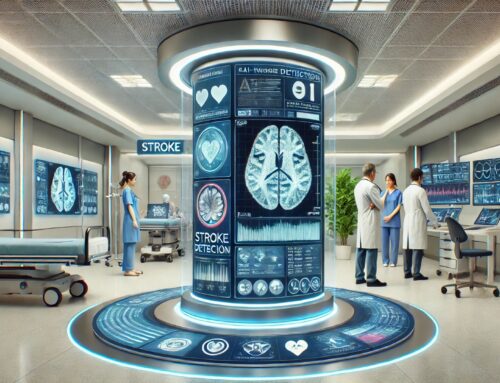Is Pokemon Coming to a Physician’s Practice Near You?
Is Pokemon coming to a health care clinic near you? “Quite possibly,” according to orthopedic surgeon Alejandro Badia MD, who has introduced a gaming-like system to his own practice. He says the new technology – called augmented reality — is rapidly growing in popularity among physicians and proving especially beneficial to orthopedic patients, enhancing the safety and accuracy of joint procedures.
Dr. Badia is using his system – the McGinley Augmented Reality device — with ultrasound to inject biologics and other healing materials into patients’ painful joints, reducing the time needed to complete the procedure and minimizing any patient discomfort. Through a special pair of goggles worn by the surgeon, the technology literally projects the ultrasound monitor image onto the joint area undergoing treatment.
“I no longer have to keep turning my head, looking at the patient’s diseased joint, then at the ultrasound monitor, and then back to the patient to properly position the injection needle,” says Dr. Badia, founder and medical director of the Miami-based Badia Hand to Shoulder Center and OrthoNOW®.
“The system allows me to maintain my gaze at the point of treatment, while viewing the ultrasound image of the inside of the patient’s joint right in front of me as I work. The goggles do not at all impede my sight lines. Meanwhile, procedure time is reduced, accuracy is ensured, and the patient ultimately benefits,” he states.
Although augmented reality (AR) and virtual reality share certain technical components, the technologies are different. Instead of taking a viewer to a “different – or virtual — world,” AR helps the surgeon literally “see” Pokemon by pairing specialized computer software with “smart glasses” to superimpose digital information in the form of images onto a real environment, namely the patient’s body. The technology can be activated through a PC computer or by simply opening an app on an iPad or mobile phone, Dr. Badia explains.
Experts indicate AR systems are becoming “all the rage” in medicine, because the technology provides crucial information during performance of procedures or operations without requiring the surgeon to repeatedly turn away from the patient to check a monitor or computer screen.
In an article published in a December 2019 issue of the Bone & Joint Journal, authors conclude that their review of past studies shows AR oftentimes results in “better outcomes…compared to traditional techniques.” Other scientists, writing in a 2020 edition of BMC Musculoskeletal Disorders, state that, unlike robotics which enhances a surgeon’s mechanical preciseness, AR “increases the ability of the surgeon by intuitive augmentation of medical information.”
An abstract published online in 2018 as part of a book series, Advances in Experimental Medicine and Biology, indicates that AR techniques also “can improve hand-eye coordination by providing [ortho] surgeons with the merged surgical scene,” enabling them to perform procedures “more easily.” In fact, 3-D visualization and AR navigational technology already have been applied successfully during spine surgery, the authors state.
The capabilities of AR are immense and growing, says Dr. Badia, who specializes in treating musculoskeletal disorders of the upper limb. He cites a July 2020 abstract in which researchers describe use of AR to ensure correct positioning of the glenoid cavity – on the lateral angle of the scapula — during shoulder joint repair, specifically reverse shoulder arthroplasty. Wyoming radiologist Joseph McGinley MD, the radiologist who worked with students in marrying AR to ultrasound and whose device Dr. Badia now uses, reports employing the technology effectively in treating carpal tunnel syndrome.
“AR has potential applications for any number of surgical and minimally invasive endoscopic procedures,” Dr. Badia states. He is planning to expand his own use of AR by combining it with fluoroscopy. Fluoroscopy employs X-rays to create real-time video or images for immediate physician review and interpretation during procedures for repairing bone fractures, treating base-of-thumb disorders, realigning bones, even measuring bone density. Augmented reality also may be useful in conjunction with CT scanning and magnetic resonance imaging for a variety of musculoskeletal interventions involving both bone and soft tissues, he indicates.
High-tech experts contend that use of specially designed AR headsets in operating rooms and outpatient settings could prove effective in collecting real-time video data and then sending the information for immediate analysis to a computer, with the intent of providing the surgeon important recommendations and precautions and tracking patient response during an actual procedure.
“We have only scratched the surface in terms of understanding the potential of this new technology,” Dr. Badia. “Augmented reality can help surgeons return patients to quality of life – and even save lives — by ensuring safer, more accurate care, with less pain and discomfort. “It’s not just for gamers anymore.”
Bio: Alejandro Badia, MD, FACS, is an internationally renowned hand and upper-limb surgeon and founder of Badia Hand to Shoulder Center and OrthoNOW®, a network of walk-in orthopedic centers. Dr. Badia is the author of Healthcare from the Trenches. http://www.drbadia.com http://www.orthonowcare.com












